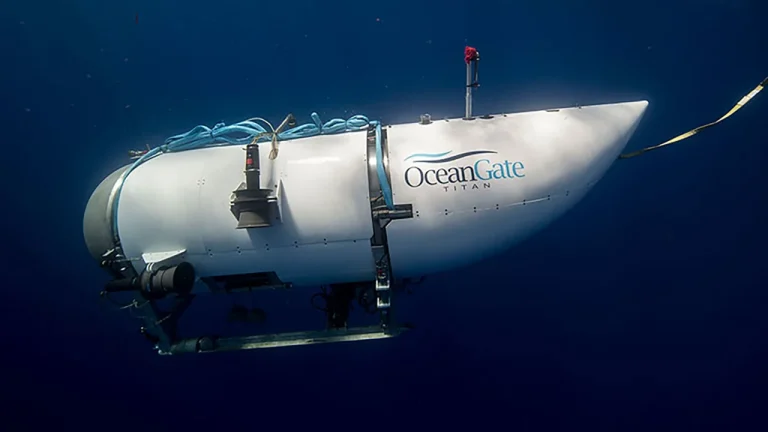Update (June 22): All five passengers onboard are presumed dead after debris recovered from the search area was consistent with a “catastrophic implosion,” US Coast Guard Rear Adm. John Mauger said during a briefing.
“This is an incredibly unforgiving environment down there on the sea floor and the debris is consistent with a catastrophic implosion of the vessel,” Mauger told reporters on Thursday, June 22.
In a twist of fate reminiscent of the ill-fated ship itself, a submarine specifically designed for deep-sea expeditions has gone missing. The 21-foot submersible, named the Titan, was last heard from during a routine dive to the wreckage of the RMS Titanic on Sunday, June 18 — sparking an unprecedented search-and-rescue mission by both the U.S Coast Guard and Canadian rescuers.
The submarine — which was operated by OceanGate, a private company founded in 2009 specializing in crewed submersibles for tourism, industry research, and exploration — embarked on a dive to the historic Titanic wreckage site located in the deep North Atlantic Ocean.
The vessel lost contact with it’s surface team about one hour and 45 minutes into its descent, and has only about 40 hours of breathable air left as of June 20, experts say.
Success
You are now signed up for our newsletter
Success
Check your email to complete sign up
The submersible, which was carrying a crew of five: CEO and co-founder of OceanGate Stockton Rush, who was also manning the sub; British adventurer and billionaire Hamish Harding; French diver Paul-Henry Nargeolet; and a Pakistani businessman and his son — was designed to withstand the immense pressures at the Titanic’s resting depth of around 12,500 feet.

Built with a carbon fiber and titanium frame, the vessel features state-of-the-art technology, and was seen as a beacon of modern deep-sea exploration.
A race against time
Upon the loss of communication, OceanGate promptly launched a coordinated search and rescue effort — working closely with international maritime authorities to search an area roughly twice the size of Connecticut, reports say. Weather conditions in the area, however, coupled with the magnitude and difficulty of the vessel’s could-be location have made the operation increasingly challenging.
“This is a search-and-rescue mission, 100 percent,” U.S. Coast Guard Capt. Jamie Frederick said during a news conference in Boston, MA on June 21. “We are smack dab in the middle of search and rescue, and we’ll continue to put every available asset that we have in an effort to find the Titan, and its crew members.”

Frederick added during the briefing that “several flights” of Canadian P3 rescue aircraft had heard “underwater banging noises” on June 19 and 20, subsequently relocating its search focus to narrow down those areas. However, as of June 21, the sounds have been “inconclusive,” and there is no confirmation whether the crew members are still alive.
“We need to have hope. But I can’t tell you what the noises are. What I can tell you is we’re searching where the noises are, and that’s all we can do at this point,” Frederick said, adding that recordings of the sounds were currently being analyzed by navy subsurface acoustics experts and scientists.
An outpouring of hope and support
The loss of the submarine has sparked an outpouring of support from the global maritime and scientific community. As the submarine was not only a vehicle for tourism but also a significant tool for underwater archeology and oceanographic research, the disappearance hits a wide array of sectors and raises new concerns about the safety protocols of these machines.
While the search for the missing submarine continues, the incident has prompted a reassessment of the risks associated with deep-sea tourism. As companies push to offer once-in-a-lifetime experiences such as a visit to the Titanic’s wreckage, questions about the safety of these undertakings have come to the forefront.

According to OceanGate’s website, it successfully conducted dives in 2021 and 2022 to the Titanic wreckage. However, concerns about the vessel’s safety (which has to be bolted from the outside and cannot be opened from inside) have come to the surface.
New concerns
“There are 10 submarines in the world that can go 12,000 ft and deeper,” Will Kohnen of the Marine Technology Society told CNN. “All of them are certified except the OceanGate submersible.”
Embarking on an expedition with OceanGate — the sole provider of dives to the Titanic site — costs $250,000 per ticket.
As the world eagerly watches, hopes remain high for the safe recovery of the submarine and its occupants. The incident serves as a stark reminder of the unpredictability of the ocean’s depths and the bravery of those who venture into this final frontier.
This is a developing story. More information will be added as it becomes available.














